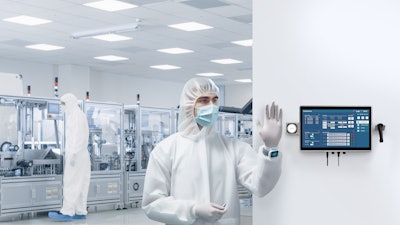
Pharmaceutical manufacturers that need to power a wide array of computing equipment now have an option that can dramatically ease the addition of new hardware when regular outlets are not readily accessible: Power over Ethernet (PoE). With PoE, electrical power is provided through the network switch and passes through a single Ethernet cable alongside data. This allows system integration and network installers to deploy powered devices in locations that lack electrical circuitry.
With the newest improved standards in high-power PoE, 802.3bt Type 3/4 PoE can now provide sufficient wattage, up to 100 watts, to power devices such as flat screens, panel PCs, thin clients and workstations commonly installed in pharmaceutical cleanrooms.
“The original PoE standards and specifications could only provide up to 30 watts of power, which was sufficient for certain types of devices, but not flat screen displays, PCs or workstations,” said Paul Shu of ARISTA Corporation, a leading provider of computing platforms and visualization display products for pharmaceutical manufacturing environments.
 With the newest improved standards in high-power PoE, up to 100 watts can now be provided to power devices such as panel PCs.ARISTA Corporation
With the newest improved standards in high-power PoE, up to 100 watts can now be provided to power devices such as panel PCs.ARISTA Corporation
The new IEEE 802.3bt standard increases the power up to 100 W by providing power over four pairs of wires, compared to the previous technology’s ability to power over just two pairs.
“This increase in wattage allows PoE to a level that will power most pharmaceutical computing equipment,” added Shu. “As an added benefit, the new standard boosts energy efficiency by minimizing power loss in the cable, potentially cutting power loss in half.”
Pharmaceutical manufacturers can now deploy a PoE enabled device within 330 feet of the network switch using a single Ethernet cable. This eliminates the cost and inconvenience of having an electrical contractor run wiring. These devices are particularly suitable for applications and locations such as cleanrooms, where it may be costly or difficult to run extra wiring.
“Although cleanrooms often have access to power, high-power PoE can streamline installation in locations where an added computer may not have readily available power and network cable connections are ubiquitous in those environments,” said Shu.
If the network switch does not provide PoE functionality, or the available PoE utilizes an earlier standard and does not provide enough power to drive the computing equipment, a POE injector can be installed. Since standard Ethernet cables can provide both data and power, there is no need to upgrade that cabling.
Arista provides a wide range of workstations, waterproof panel and thin client PCs that can be powered by PoE. To maximize the use of space in constrained pharmaceutical facilities, many of these items are available in wall, ceiling and pedestal-mounted versions.
 Arista provides a wide range of workstations, waterproof panel, and thin client PCs that can be powered by PoE.ARISTA Corporation
Arista provides a wide range of workstations, waterproof panel, and thin client PCs that can be powered by PoE.ARISTA Corporation
Like other computing platform elements in pharmaceutical manufacturing environments, the PCs are designed and tested to withstand the high humidity and moisture generated during manufacturing, as well as the caustic chemicals used for cleaning. To accomplish this, the equipment is built using stainless steel NEMA 4X/IP66 enclosures.
Since individual pharmaceutical facilities often have unique requirements, the PoE powered computing systems can be further customized if needed. Depending upon the level of change needed, the process can range anywhere from six to eight weeks for minor customization to several months for more extensive projects.
Today, the pharmaceutical industry needs greater flexibility in powering all manner of computing devices throughout a facility. PoE-enabled workstations and PCs can quickly and easily receive power through an existing network cable. With no need for an electrical contractor or costly rewiring, pharma plants can easily add or reconfigure the needed computing equipment whenever and wherever required for greater efficiency.























